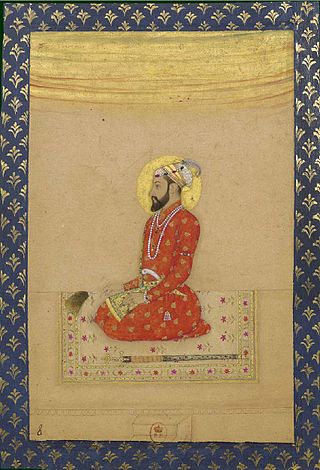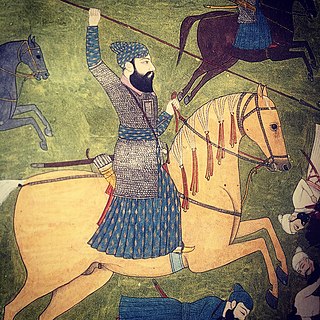
Bahadur Shah I, also known as Muhammad Mu'azzam and Shah Alam I was the eighth Mughal Emperor who ruled from 1707 until his death in 1712. In his youth, he conspired to overthrow his father Aurangzeb, the sixth Mughal emperor, and ascend to the throne. He was governor of Akbarabad, Kabul and Lahore. Bahadur Shah was also Aurangzeb's third son.

Farrukhsiyar or Farrukh Siyar was the tenth emperor of the Mughal Empire from 1713 to 1719. He rose to the throne after assassinating his uncle, Emperor Jahandar Shah. Reportedly a handsome man who was easily swayed by his advisers, he lacked the ability, knowledge and character to rule independently. He was an emperor only in name, with all effective power in the hands of the Sayyids of Barah. Farrukhsiyar was the son of Azim-ush-Shan and Sahiba Niswan.

The Sikh Empire was a state originating in the Indian subcontinent, formed under the leadership of Maharaja Ranjit Singh, who established an empire based in the Punjab. The empire existed from 1799, when Maharaja Ranjit Singh captured Lahore, to 1849, when it was defeated and conquered in the Second Anglo-Sikh War. It was forged on the foundations of the Khalsa from a collection of autonomous Sikh Misl. At its peak in the 19th century, the Empire extended from the Khyber Pass in the west to western Tibet in the east, and from Mithankot in the south to Kashmir in the north. It was divided into four provinces: Lahore, in Punjab, which became the Sikh capital; Multan, also in Punjab; Peshawar; and Kashmir from 1799 to 1849. Religiously diverse, with an estimated population of 4.5 million in 1831, it was the last major region of the Indian subcontinent to be annexed by the British Empire.
Dal Khalsa was the name of the combined forces of 12 Sikh misls that operated in the 18th century (1735–1780) in the Punjab region.
Sadhaura is a city, near Yamunanagar city with Municipal Committee in Yamunanagar district in the Indian state of Haryana. A city of Yamunanagar, it is of great historic significance. Sadhaura is very old town many historical temples/Dargah are there like Manokamna Temple, Laxmi narayan Temple, Roza Peer Dargah are some famous places in Sadhaura.

The Fateh Burj, is one of most beautiful tourist places in Punjab and the tallest tower in India, is situated in the historical village of Chappar Chiri in the SAS Nagar district of Punjab state. It was completed in 2011. The 328 feet (100 m) tower is dedicated to establishment of the Sikh Misls in a large part of Punjab in 1711. It is situated in Banda Singh Bahadur Road. It is situated just outside Mohali, a 140kilometres from Amritsar and 20 km from Sirhind. It was here that Banda Singh Bahadur, one of the most respected and great Sikh warriors, won a decisive battle against Wazir Khan, commander of the Mughal army.

Banda Singh Bahadur, was a Sikh warrior and a commander of Khalsa army. At age 15, he left home to become an ascetic, and was given the name Madho Das Bairagi. He established a monastery at Nānded, on the bank of the river Godāvarī. In 1707, Guru Gobind Singh accepted an invitation to meet Bahadur Shah I in southern India, he visited Banda Singh Bahadur in 1708. Banda became disciple of Guru Gobind Singh and was given a new name, Gurbaksh Singh(as written in Mahan Kosh), after the baptism ceremony. He is popularly known as Banda Singh Bahadur. He was given five arrows by the Guru as a blessing for the battles ahead. He came to Khanda in Sonipat and assembled a fighting force and led the struggle against the Mughal Empire.
Lohgarh is a historic town in Bilaspur tehsil of Yamunanagar district of Haryana in India. It was the capital of the Sikh state under Baba Banda Singh Bahadur from 1710 to 1716.
Baba Binod Singh, a descendant of Guru Angad, was an army man and disciple of Guru Gobind Singh and was among few Sikhs who accompanied him to Nanded in 1708. In Budha Dal Chronicles, Guru Gobind Singh made Baba Binod Singh the head of the Khalsa.
The siege of Sirhind was fought between the Mughal Empire and Sikh forces in 1710. The Sikhs besieged, stormed, captured, plundered and razed the city of Sirhind after defeating and beheading Wazir Khan in the battle of Chappar Chiri.

The Battle of Gurdas Nangal was a battle that took place in April 1715 between the Sikhs, led by Banda Singh Bahadur, and the Mughals, led by Abd al-Samad Khan. Banda at that time was carrying out operations and small raids to the north of Amritsar. During these operations, the Mughal Army confronted the Sikhs. When confronted, the Sikhs quickly retired northwards to take shelter in the fort of Gurdaspur. It had been recently extended to accommodate 60,000 horses and food. Large stores of grain and fodder had also been collected there. The Mughal Army converged upon the fort from three sides. The Delhi force of 20.000 men under Qamar-ud-din Khan advanced from the east. The Lahore troops consisting of 10,000 men under Abd al-Samad Khan marched from the south. And the Jammu troops numbering nearly 5,000, under Zakariya Khan, moved from the north. To the west of the fort was the River Ravi, which had no bridge over it. All the boats had been withdrawn to the opposite bank which was closely guarded by numerous local chiefs and government officials. The pursuit made it so the Sikhs could not enter the fort at Gurdaspur. Thus, the army quickly turned west.
The Mughal emperor Bahadur Shah's army moved towards Lohgarh where they engaged with the Sikhs to capture the fort on 16 December 1710.
The Battle of Jammu was fought between the Sikhs under the command of Banda Singh Bahadur against the Mughal forces near the hills of Jammu on January 22, 1712. The Mughals were able to achieve victory against the Sikhs.
The Battle of Jalalabad occurred in 1710 between the Mughal forces of Jalal Khan and the Sikh forces of Banda Singh Bahadur. Banda Singh Bahadur attacked the Mughal stronghold of Jalalabad. The army opposing Banda Singh was composed of a sizeable number of the Muslim zamindars and shurafa, including many Sadat, Banda Singh Bahadur repelled Mughal and Pathan forces after four days from the battlefield and back into the city, but failed to capture the city and withdrew.

The battle of Chappar Chiri, also called Battle of Sirhind, was fought between Mughal Empire and the Sikhs on 12 May 1710 at Chappar Chiri, located 20 kilometers from Sirhind
The Battle of Sadhaura was fought between Sikhs and the combined forces of the Sayyids and the Sheikhs in Sadhaura in 1710. The imperial forces were defeated and took refuge behind the city's walls. Banda's forces captured the fort and levelled it to the ground. It resulted in a victory for the Sikhs where Banda Singh Bahadur defeated Osman Khan.
The Battle of Rahon was fought between Sikhs and Mughal Empire on 11 October 1710.

Chaar Sahibzaade 2: Rise of Banda Singh Bahadur is 2016 Indian Punjabi-language 3D computer-animated film, directed and produced by Harry Baweja. It is a sequel to the 2014 film Chaar Sahibzaade. The film was released on 11 November 2016.
Bhai Lakhishah Banjara was a warrior and Banjara king, Asian trader, civil contractor and the owner of four villages located in Delhi. He was also supplying goods for the Mughal Army.

Fateh Singh was a warrior in Sikh history. He is known for beheading Wazir Khan who was the Mughal Governor of Sirhind, administering a territory of the Mughal Empire between the Sutlej and Yamuna rivers. Wazir Khan was infamous for ordering the execution of the two young sons of Guru Gobind Singh, Sahibzada Fateh Singh and Sahibzada Zorawar Singh in 1704.









